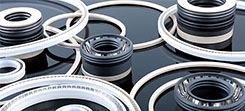Ensuring Optimal Performance of PTFE Seals
In the realm of industrial sealing, the selection of seal materials is a critical decision that can significantly impact the performance and longevity of equipment. One of the most important factors to consider when choosing seals is the compatibility between the seal material and the media it will encounter during operation. For PTFE (polytetrafluoroethylene) seals, this consideration is particularly vital due to their widespread use in demanding environments where chemical resistance and durability are paramount.
PTFE is renowned for its exceptional chemical resistance, low friction properties, and ability to operate across a broad temperature range. These characteristics make PTFE seals a preferred choice in industries such as chemical processing, pharmaceuticals, oil and gas, and food and beverage, where they are often exposed to aggressive chemicals, extreme temperatures, and high pressures. However, to fully leverage the advantages of PTFE seals, it is essential to understand the nuances of material and media compatibility.
Chemical Compatibility
PTFE's chemical inertness is one of its most valuable properties. It is highly resistant to a wide range of chemicals, including acids, bases, solvents, and hydrocarbons, making it an excellent choice for sealing applications where chemical exposure is a concern. However, not all chemicals interact with PTFE in the same way. While PTFE can withstand harsh environments, certain chemicals, particularly fluorinated hydrocarbons, may cause slight degradation over extended periods. Understanding the specific chemical composition of the media is essential to ensuring that the PTFE seal will maintain its integrity and effectiveness over time.
For applications involving chemicals that may cause PTFE to degrade, it may be necessary to consider PTFE composites or modified PTFE materials that include fillers such as glass, carbon, or bronze. These additives can enhance the chemical resistance and mechanical properties of the seal, providing additional protection against chemical attack.
Temperature Compatibility
PTFE seals are capable of operating in a wide temperature range, from cryogenic levels to high heat environments. However, temperature extremes can affect the material's properties and, consequently, the performance of the seal. At low temperatures, PTFE remains flexible and does not become brittle, making it suitable for applications in cold environments. On the other hand, at elevated temperatures, PTFE maintains its stability and does not soften or degrade, which is crucial for high-temperature applications.
Nevertheless, continuous exposure to temperatures near the upper limit of PTFE's range (approximately 260°C or 500°F) can lead to gradual material degradation, such as creep or loss of mechanical strength. To address this, PTFE seals may be reinforced with fillers that enhance their thermal stability, ensuring reliable performance even under prolonged high-temperature conditions.
Pressure and Mechanical Stress
While PTFE is chemically resistant and thermally stable, its mechanical properties under high pressure or stress can present challenges. Pure PTFE is relatively soft and may experience extrusion or deformation when subjected to high pressures, especially in dynamic sealing applications. This can lead to leaks and compromised seal integrity.
To counteract these issues, PTFE seals can be reinforced with fillers that improve their mechanical strength and resistance to deformation. For instance, adding glass or carbon fibers to PTFE increases its compressive strength and reduces the risk of extrusion. Additionally, these fillers can enhance the wear resistance of PTFE seals, making them more suitable for applications involving significant mechanical stress or high-speed motion.
Conclusion
For companies utilizing PTFE seals in their industrial operations, ensuring material and media compatibility is crucial for achieving optimal seal performance and longevity. By thoroughly assessing the chemical, temperature, and pressure conditions of the operating environment, and selecting the appropriate PTFE formulation-whether pure or filled-engineers can prevent premature seal failure and enhance the overall efficiency and safety of their systems.
In the competitive landscape of industrial sealing, choosing the right PTFE seal based on comprehensive compatibility analysis is not just a best practice-it's a strategic advantage. As industries continue to push the boundaries of operational demands, the ability to match seal materials to their specific environments will remain a key factor in maintaining reliability and performance.


 Resources&Tools
Resources&Tools
 Resources&Tools
Resources&Tools






